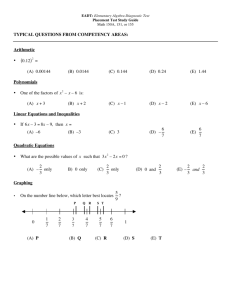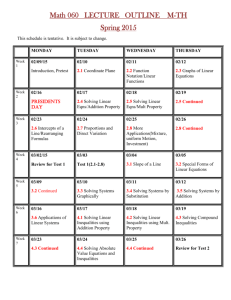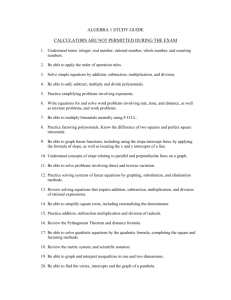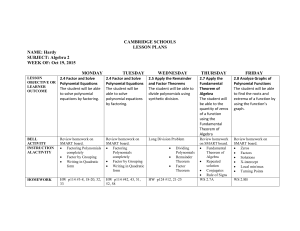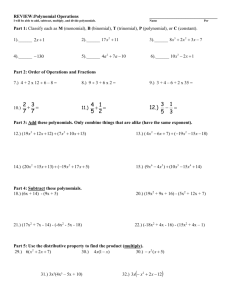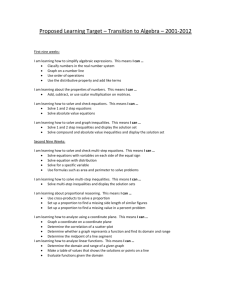File
advertisement
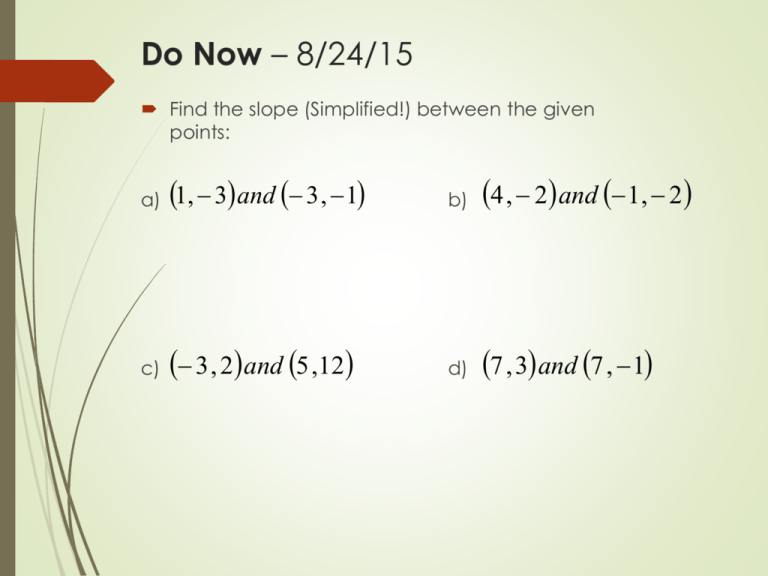
Do Now – 8/24/15 Find the slope (Simplified!) between the given points: a) 1, 3 and 3 , 1 b) 4 , 2 and 1, 2 c) 3 , 2 and 5 ,12 d) 7 , 3 and 7 , 1 Forms of Linear Equations Slope-Intercept Form Point-Slope Form Standard Form Writing a Linear Equation Write the equation of a line that passes through the point (-3 , 6) with a slope of -1. Writing a Linear Equation Write the equation of a line that passes through the point (-3 , 1) with a slope of -2. Writing a Linear Equation Write the equation of a line that passes through the points (-3 , 1) and (1 , 9). Parallel and Perpendicular Lines Parallel Lines have the same slope. Perpendicular Lines have opposite reciprocal slopes. Writing a Linear Equation Write the equation of a line that passes through the point (4 , 3) and is parallel to y 2 x 3 . Write the equation of a line that passes through the point (4 , 3) and is perpendicular to y 2 x 3 . Writing Linear Equations a) Write the equation of a line that passes through the point (-2 , 3) and is perpendicular to y 1 x7 3 b) Write the equation of a line that passes through the point (-3 , 1) with a slope of 0. c) Write the equation of a line that passes through the points (1 , -4) and (-2 , -10). Graphing a Linear Equation Graph: y 3 x 5 Graphing a Linear Equation Graph: y 3 1 x 2 2 Graphing a Linear Equation Graph: 2 x 3 y 18 Learning Log Summary LT 1 – I can graph linear equations in one variable and write equations based on a graph or given information. The forms of linear equations are… They are useful when… Closure Homework (record on Learning Log): LT 1: pg. 116 ~ 1-29 (O) pg. 121 ~ 3-36 (Every 3rd problem) Systems of Linear Equations Example: 3x y 4 x y 70 What is the objective when solving a system of equations? Methods to solve a system of equations: 1) 2) 3) Student Work Critique For each piece of student work: -Identify what method they used to solve the system. -Identify the strengths of that method. -Identify the weaknesses of that method. -Look over their work and offer feedback. Student Work Critique Student Work Critique Student Work Critique Student Work Critique Possible Solutions to a System of Equations Intersecting Lines 1 Solution Parallel Lines No Solution Same Line Infinite Solutions Solving a System of Equations Solve: 4x 3y 5 2 x 5 y 17 1, 3 Solving a System of Equations Solve: 3 x 4 y 14 4 x 10 y 11 1 4, 2 Solving a System of Equations x 2y 1 Solve: 1 y x4 2 Solving a System of Equations Solve: 3 x 5 y 6 6 x 10 y 12 6 0 , , 2 , 0 , 7 , 3 5 Practice: Solving a System of Equations Solve: Solve: Solve: 2 x y 2 2 x 3 y 15 2x y 2 x x 2y 2 y y 5x x y 10 Learning Log Summary LT 2 – I can solve a system of equations in two variables. The methods I can use to solve a system are… The types of solutions to a system are… Common mistakes when solving a system of equations are… Closure Homework (record on Learning Log): LT 1: pg. 129 ~ 13-27 (O) Linear Inequalities A linear inequality in two variables makes a comparison (<, >, etc.) of two expressions. A solution is an ordered pair that must satisfy the inequality. Are these points solutions to the statement y x 3 ? Point 1: (2, -5) Point 2: (5, -5) Point 3: (-3, 0) Point 4: (-8, 2) Point 5: (-4, 5) Point 6: (4,-5) Point 7: (-1, 10) Point 8: (1, 0) Is there a way to represent ALL solutions to: y x 3 ? Represent all solutions to: y 2x 3 Associated Equation: Line Type: Test point: y 2x 3 Represent all solutions to: 3x 2 y 4 0 Associated Equation: Line Type: Test point: Represent all solutions to: x 2 Associated Equation: Line Type: Test point: y5 Represent all solutions to: 2 y 3 x 1 3 Associated Equation: Line Type: Test point: Learning Log Summary LT 3 (pt 1) – I can graph linear inequalities in two variables. Steps to graph a linear inequality… A method to know where to shade is… Closure Homework (record on Learning Log): LT 3: pg. 138 ~ Oral Exercises 13-16 Written Exercises 1-17 (O) System of Linear Inequalities How do you know if (-1 , 3) is a solution to: x 2 y 1 How do you know if (-1 , 3) is a solution to: x 2 y 1 2x y 0 System of Linear Inequalities Graph the solution to: y x 2 y 5 x 2 System of Linear Inequalities x 3 Graph the solution to: 5 y x2 3 System of Linear Inequalities Graph the solution to: 3 x 2 y 2 x 2y 2 Learning Log Summary LT 3 – I can graph linear inequalities in two variables and graph systems of linear inequalities. Steps to graph a system of linear inequalities… A method to know where to shade is… Closure Homework (record on Learning Log): LT 3 (pt 2): System of Inequalities Wksht Functions Assign each number to the number of letters in its name. D R 0 1 3 2 3 4 4 5 5 Functions A function is a correspondence between two sets, D and R, that assigns each member of D to exactly one member of R. D R 0 1 3 2 3 4 4 5 5 Functions Functions are named by letters: g : x 2x “g, the function that assigns x to 2x” D 0 1 2 3 4 5 R Functions Given: f : x 2x x 2 a) Find the range of f. b) Graph f. , with domain D 1, 2 , 3 , 4 , 5 Functions The value of a function are the numbers in the range that correspond to numbers in the domain. To evaluate a function, we find the output for a certain input. If f x x 3x , then f 2 ? If f x x 2 3x , then f 3 ? 2 Functions Given f x 2 x 3 a) f 1 b) g 3 c) f g 3 d) g f 1 and g x x 2 1 , find: Functions Given: f x x 3 , with a) Find the range of f. b) Graph f(x) D 4 , 3 , 2 , 1, 0 ,1, 2 Functions Sometimes the domain of a function is not given. The implied domain of a function is the set of x-values (inputs) that produce real number outputs. Ex) What is the domain of f x x 3 ? Functions Find the implied domain of each function: a) f x 5 x b) g x x 2 3 c) 1 h x x3 Learning Log Summary LT 4 – I can define a function and use it to evaluate and graph. A function is… To evaluate a function… f(x) means… Closure Homework (record on Learning Log): LT 4: pg. 143 ~ O.E. 2-16 (even) W.E. 3-39 (every 3rd) Functions A function is a correspondence between two sets, D and R, that assigns each member of D to exactly one member of R. D R Aaron Beth LCHS Carl Deb Chipotle Edith Frank Home Relations A relation is any set of ordered pairs. The set of first coordinates is the domain of the relation, and the set of the second coordinates is the range. Relations Ex) Is the relation shown below a function? D R 0 1 3 2 3 4 4 5 5 Relations Ex) Is the relation shown below a function? 2 , 0 1,1 0 ,1 1, 2 2 , 4 Relations Ex) Is the relation shown below a function? 0 , 4 1, 3 2 , 3 4 , 4 4 , 5 Relations Ex) Is the relation shown below a function? Relations Ex) Is the relation shown below a function? Relations The Vertical Line Test – A relation is a function if and only if no vertical line intersects its graph more than once. Domain and Range The domain is a collection of the possible x-values. The range is a collection of possible y-values. Domain and Range The domain is a collection of the possible x-values. The range is a collection of possible y-values. Learning Log Summary LT 5 – I can graph functions and determine when relations are also functions. A relation is… A relation is different than a function… Closure Remind your parents about the location of this class for Back to School Night tomorrow. Room # and Period #! On the index card, write one thing you think I should share with them tomorrow night. Closure Homework (record on Learning Log): LT 4: pg. 155 ~ O.E. 1-19 W.E. 1-4 Warm-Up – 9/8/15 Multiply the following: a) x 2 x 3 2 x b) x 2 x3 2 x c) x 2 1 x3 2 x What is the different between (a) and (b)? How does that change the multiplication? What is the difference between (b) and (c)? How does that change the multiplication? Multiplying Polynomials Multiply: 2827 “Traditional Model”: 28 27 Area Model: 20 820 7 Multiplying Polynomials Multiply: x 8x 7 Could we use the distributive property differently? x 8x 7 Multiplying Polynomials Multiply: Multiply: x 2 x 3x 1 x 2 5 x 2 2 3x 1 x 2 2 Multiplying Polynomials: Special Patterns Expand and multiply: 1. x+1 2 2. x−5 2 3. 2x + 1 4. 2m − 3n 2 2 MAKE A GENERALIZATION: “When multiplying 𝒂 ± 𝒃 𝟐 , the product is.. __________±_________+_________ Multiplying Polynomials: Special Patterns Expand and multiply: 1. (𝑥 + 1)(𝑥 − 1) 2. (𝑥 − 5)(𝑥 + 5) 3. (2𝑥 + 1)(2𝑥 − 1) 4. (2𝑚 − 3𝑛)(2𝑚 + 3𝑛) 5. MAKE A GENERALIZATION: “When multiplying (𝒂 + 𝒃)(𝒂 − 𝒃), the product is.. Multiplying Polynomials Multiply: x 1x 32 x 1 Extending our Understanding Expand and multiply: 1. x 2. x 3. 4. 2 y2 x2 y2 3 y 3 x3 y 3 x 5 y 5 x5 y 5 x n yn xn yn MAKE A GENERALIZATION: “When multiplying x y n n x n y n the product is.. Practice Multiply: 1. a b 3 2. r 3. p 4. a b a 2 2ab b 2 n 1 2 n s n r n 2s n Learning Log Summary LT 8 – I can simplify the product of polynomials, including special cases. Multiplying polynomials is like the distributive property because… If the factors are the sides of a rectangle, the area is… Closure Homework (record on Learning Log): LT 8: pg. 175 ~ 1-31 (O) Multiplying Polynomials: Special Patterns Expand and multiply: 1. (𝑥 + 1)(𝑥 − 1) 2. (𝑥 − 5)(𝑥 + 5) 3. (2𝑥 + 1)(2𝑥 − 1) 4. (2𝑚 − 3𝑛)(2𝑚 + 3𝑛) 5. MAKE A GENERALIZATION: “When multiplying (𝒂 + 𝒃)(𝒂 − 𝒃), the product is.. Multiplying Polynomials: Special Patterns (Refresher) Expand and multiply: 1. x+1 2 2. x−5 2 3. 2x + 1 4. 2m − 3n 2 2 MAKE A GENERALIZATION: “When multiplying 𝒂 ± 𝒃 𝟐 , the product is.. __________±_________+_________ Multiplying Polynomials Multiply: 3x 2 2 x 2 5 x 1 Multiplying Polynomials 3x 2 2 x 2 5 x 1 6 x 4 15 x 3 3 x 2 Factoring Polynomials 6 x 4 15 x 3 3 x 2 3x 2 2 x 2 5 x 1 Factoring a polynomial means to re-write it using multiplication. Factoring Techniques (so far…) • Factor out a GCF Ex) 3 x 4 15 x 3 3 x 2 3 x 2 x 2 5 x 1 Review from Wednesday… Factor out the GCF of: 2 x 3 12 x 2 18 x Can we factor further? Factoring Techniques (so far…) • Special Pattern: Perfect Square Trinomial • Ex) a 2 2ab b 2 a b 2 x 2 6 x 9 x 3 2 Review from Wednesday… Factor out the GCF of: 2 x 2 18 Can we factor further? Factoring Techniques (so far…) • Special Pattern: Difference of Squares • Ex) a 2 b 2 a b a b x 2 9 x 3 x 3 Review from Wednesday… Factor out the GCF of: 2 x 4 54 x Can we factor further? Factoring Techniques (so far…) • Special Pattern: Sum/Difference of Cubes • a 3 b 3 a b a 2 ab b 2 S • Ex) O AP a 3 b 3 a b a 2 ab b 2 x 3 27 x 3 x 2 3 x 9 Learning Log Summary LT 10 – I can factor polynomials by using the GCF, by recognizing patterns, and by grouping. To factor means… Special cases of factoring include… Closure Homework (record on Learning Log): LT 10: pg. 185 ~ 1-22 (All) Factoring Polynomials Multiply: x 8x 7 Factoring Polynomials Factor: x 2 15 x 56 Factoring Polynomials Factor: x 2 8 x 15 Factoring Polynomials Factor: x 2 2 x 15 Factor: x 2 2 x 15 Factoring Polynomials Factor: 3x 2 8 x 5 Factoring Polynomials Factor: 4r 2 8r 3 Factoring Polynomials Factor: 6 s 2 st 5t 2 Learning Log Summary LT 11 – I can factor quadratic polynomials and identify prime polynomials. To factor means… A strategy to factor polynomials is… Closure Homework (record on Learning Log): LT 10: pg. 191 ~ 1-29 (Odds) Warm-Up Factor completely: x 2 3 x 10 3 x 6 48 x 2 Solving Polynomial Equations Find a solution to the equation by guess-and-check: x 2 3 x 10 0 Zero Product Property If a b 0 , then either a=0 or b=0. Product x 2 3 x 10 0 Can we re-write as a product? Solving Polynomial Equations Solve: x 2 x 30 Solving Polynomial Equations Solve: 3x 3 4 x2 x 1 Solving Polynomial Equations The solutions to a polynomial equation can also be called “roots” or “zeros” since they are the values of the equation that produce an output of 0. Find the roots of: 3 f x x 4 43 x 16 Learning Log Summary LT 12 – I can solve polynomial equations using factoring and the Zero Product Property. To factor means… A strategy to factor polynomials is… Closure Homework (record on Learning Log): LT 12: pg. 196 ~ 1-20 (All)
